Medicines: Comprehensive Review of Sources, Types, Safety, and Effects
VerifiedAdded on 2022/04/26
|25
|8694
|32
Report
AI Summary
This report provides a comprehensive overview of medicines, covering their sources, types, and safety considerations. It begins with an introduction to medicines, their uses, and the role of regulatory bodies like NAFDAC. The report then delves into the various sources of medicines, including plants, animals, microbes, marine organisms, minerals, and synthetic/chemical derivatives, as well as semi-synthetic and biosynthetic sources. Each source is described with examples of drugs derived from them. The report aims to compare herbal and orthodox medicines, examining their safety and side effects. It defines herbal medicines and discusses their significance in traditional medicine. The objectives include reviewing herbal and orthodox medicines, examining their safety, and assessing their side effects, thereby providing a thorough understanding of different medicine types and their implications. This report is intended to provide students with a detailed understanding of medicines and their diverse origins.
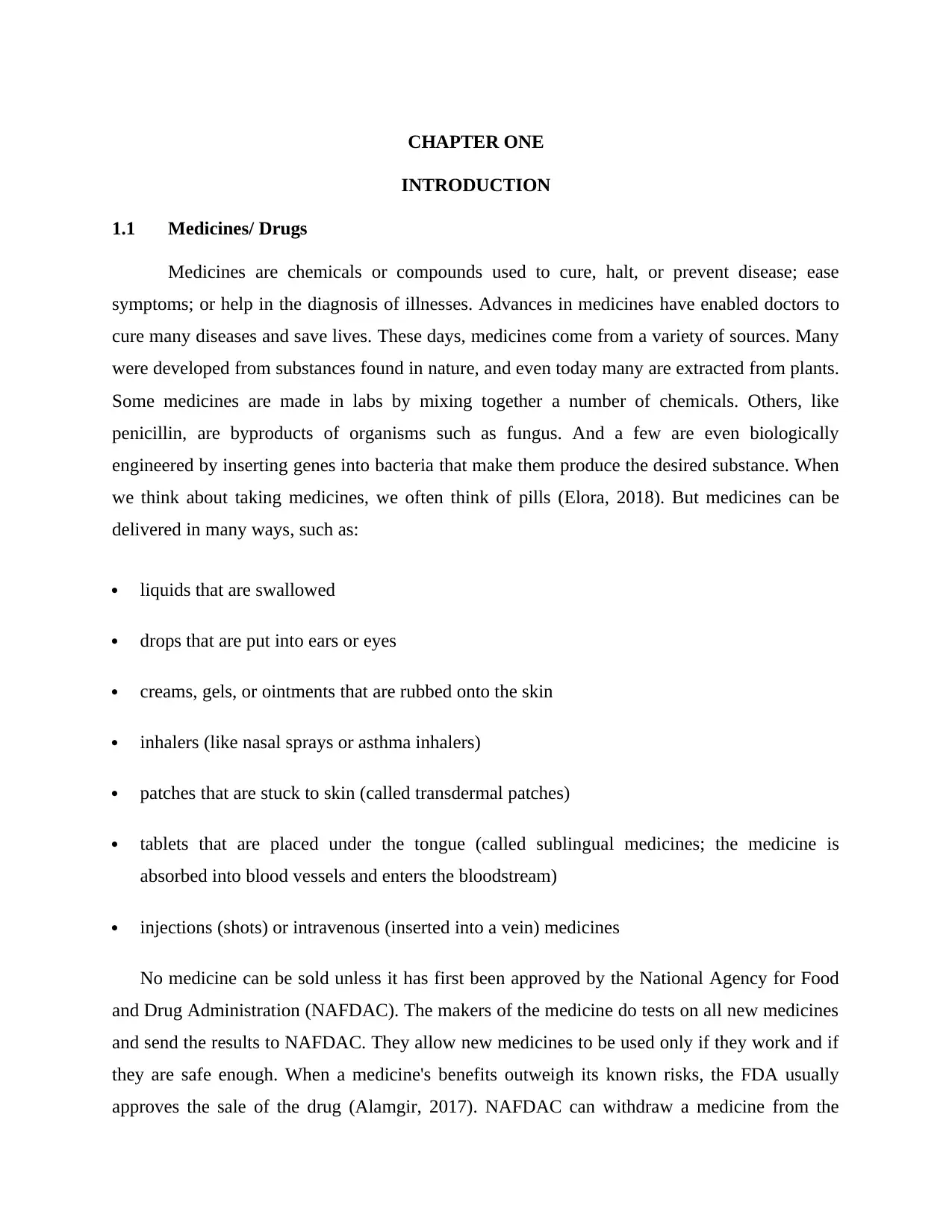
CHAPTER ONE
INTRODUCTION
1.1 Medicines/ Drugs
Medicines are chemicals or compounds used to cure, halt, or prevent disease; ease
symptoms; or help in the diagnosis of illnesses. Advances in medicines have enabled doctors to
cure many diseases and save lives. These days, medicines come from a variety of sources. Many
were developed from substances found in nature, and even today many are extracted from plants.
Some medicines are made in labs by mixing together a number of chemicals. Others, like
penicillin, are byproducts of organisms such as fungus. And a few are even biologically
engineered by inserting genes into bacteria that make them produce the desired substance. When
we think about taking medicines, we often think of pills (Elora, 2018). But medicines can be
delivered in many ways, such as:
liquids that are swallowed
drops that are put into ears or eyes
creams, gels, or ointments that are rubbed onto the skin
inhalers (like nasal sprays or asthma inhalers)
patches that are stuck to skin (called transdermal patches)
tablets that are placed under the tongue (called sublingual medicines; the medicine is
absorbed into blood vessels and enters the bloodstream)
injections (shots) or intravenous (inserted into a vein) medicines
No medicine can be sold unless it has first been approved by the National Agency for Food
and Drug Administration (NAFDAC). The makers of the medicine do tests on all new medicines
and send the results to NAFDAC. They allow new medicines to be used only if they work and if
they are safe enough. When a medicine's benefits outweigh its known risks, the FDA usually
approves the sale of the drug (Alamgir, 2017). NAFDAC can withdraw a medicine from the
INTRODUCTION
1.1 Medicines/ Drugs
Medicines are chemicals or compounds used to cure, halt, or prevent disease; ease
symptoms; or help in the diagnosis of illnesses. Advances in medicines have enabled doctors to
cure many diseases and save lives. These days, medicines come from a variety of sources. Many
were developed from substances found in nature, and even today many are extracted from plants.
Some medicines are made in labs by mixing together a number of chemicals. Others, like
penicillin, are byproducts of organisms such as fungus. And a few are even biologically
engineered by inserting genes into bacteria that make them produce the desired substance. When
we think about taking medicines, we often think of pills (Elora, 2018). But medicines can be
delivered in many ways, such as:
liquids that are swallowed
drops that are put into ears or eyes
creams, gels, or ointments that are rubbed onto the skin
inhalers (like nasal sprays or asthma inhalers)
patches that are stuck to skin (called transdermal patches)
tablets that are placed under the tongue (called sublingual medicines; the medicine is
absorbed into blood vessels and enters the bloodstream)
injections (shots) or intravenous (inserted into a vein) medicines
No medicine can be sold unless it has first been approved by the National Agency for Food
and Drug Administration (NAFDAC). The makers of the medicine do tests on all new medicines
and send the results to NAFDAC. They allow new medicines to be used only if they work and if
they are safe enough. When a medicine's benefits outweigh its known risks, the FDA usually
approves the sale of the drug (Alamgir, 2017). NAFDAC can withdraw a medicine from the
Paraphrase This Document
Need a fresh take? Get an instant paraphrase of this document with our AI Paraphraser
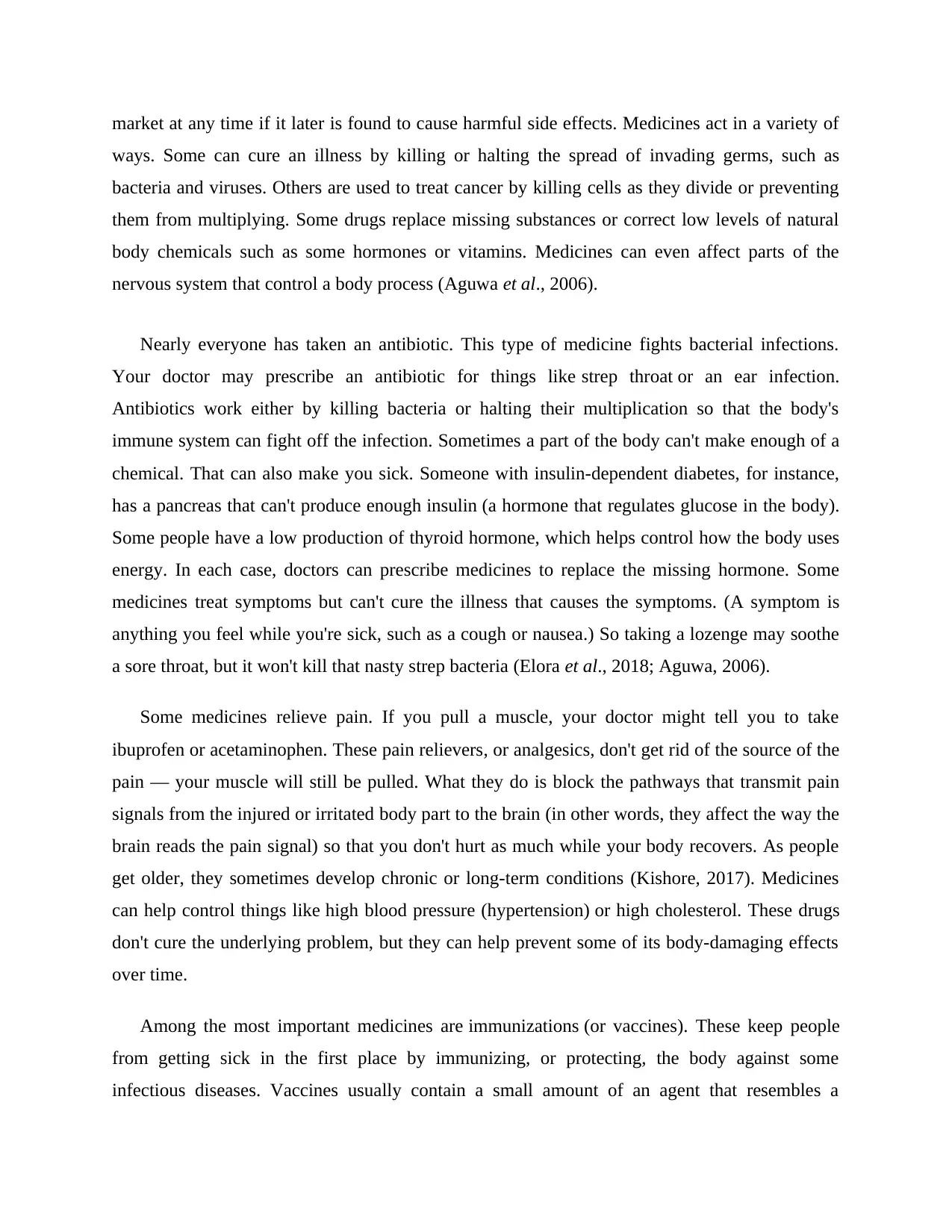
market at any time if it later is found to cause harmful side effects. Medicines act in a variety of
ways. Some can cure an illness by killing or halting the spread of invading germs, such as
bacteria and viruses. Others are used to treat cancer by killing cells as they divide or preventing
them from multiplying. Some drugs replace missing substances or correct low levels of natural
body chemicals such as some hormones or vitamins. Medicines can even affect parts of the
nervous system that control a body process (Aguwa et al., 2006).
Nearly everyone has taken an antibiotic. This type of medicine fights bacterial infections.
Your doctor may prescribe an antibiotic for things like strep throat or an ear infection.
Antibiotics work either by killing bacteria or halting their multiplication so that the body's
immune system can fight off the infection. Sometimes a part of the body can't make enough of a
chemical. That can also make you sick. Someone with insulin-dependent diabetes, for instance,
has a pancreas that can't produce enough insulin (a hormone that regulates glucose in the body).
Some people have a low production of thyroid hormone, which helps control how the body uses
energy. In each case, doctors can prescribe medicines to replace the missing hormone. Some
medicines treat symptoms but can't cure the illness that causes the symptoms. (A symptom is
anything you feel while you're sick, such as a cough or nausea.) So taking a lozenge may soothe
a sore throat, but it won't kill that nasty strep bacteria (Elora et al., 2018; Aguwa, 2006).
Some medicines relieve pain. If you pull a muscle, your doctor might tell you to take
ibuprofen or acetaminophen. These pain relievers, or analgesics, don't get rid of the source of the
pain — your muscle will still be pulled. What they do is block the pathways that transmit pain
signals from the injured or irritated body part to the brain (in other words, they affect the way the
brain reads the pain signal) so that you don't hurt as much while your body recovers. As people
get older, they sometimes develop chronic or long-term conditions (Kishore, 2017). Medicines
can help control things like high blood pressure (hypertension) or high cholesterol. These drugs
don't cure the underlying problem, but they can help prevent some of its body-damaging effects
over time.
Among the most important medicines are immunizations (or vaccines). These keep people
from getting sick in the first place by immunizing, or protecting, the body against some
infectious diseases. Vaccines usually contain a small amount of an agent that resembles a
ways. Some can cure an illness by killing or halting the spread of invading germs, such as
bacteria and viruses. Others are used to treat cancer by killing cells as they divide or preventing
them from multiplying. Some drugs replace missing substances or correct low levels of natural
body chemicals such as some hormones or vitamins. Medicines can even affect parts of the
nervous system that control a body process (Aguwa et al., 2006).
Nearly everyone has taken an antibiotic. This type of medicine fights bacterial infections.
Your doctor may prescribe an antibiotic for things like strep throat or an ear infection.
Antibiotics work either by killing bacteria or halting their multiplication so that the body's
immune system can fight off the infection. Sometimes a part of the body can't make enough of a
chemical. That can also make you sick. Someone with insulin-dependent diabetes, for instance,
has a pancreas that can't produce enough insulin (a hormone that regulates glucose in the body).
Some people have a low production of thyroid hormone, which helps control how the body uses
energy. In each case, doctors can prescribe medicines to replace the missing hormone. Some
medicines treat symptoms but can't cure the illness that causes the symptoms. (A symptom is
anything you feel while you're sick, such as a cough or nausea.) So taking a lozenge may soothe
a sore throat, but it won't kill that nasty strep bacteria (Elora et al., 2018; Aguwa, 2006).
Some medicines relieve pain. If you pull a muscle, your doctor might tell you to take
ibuprofen or acetaminophen. These pain relievers, or analgesics, don't get rid of the source of the
pain — your muscle will still be pulled. What they do is block the pathways that transmit pain
signals from the injured or irritated body part to the brain (in other words, they affect the way the
brain reads the pain signal) so that you don't hurt as much while your body recovers. As people
get older, they sometimes develop chronic or long-term conditions (Kishore, 2017). Medicines
can help control things like high blood pressure (hypertension) or high cholesterol. These drugs
don't cure the underlying problem, but they can help prevent some of its body-damaging effects
over time.
Among the most important medicines are immunizations (or vaccines). These keep people
from getting sick in the first place by immunizing, or protecting, the body against some
infectious diseases. Vaccines usually contain a small amount of an agent that resembles a
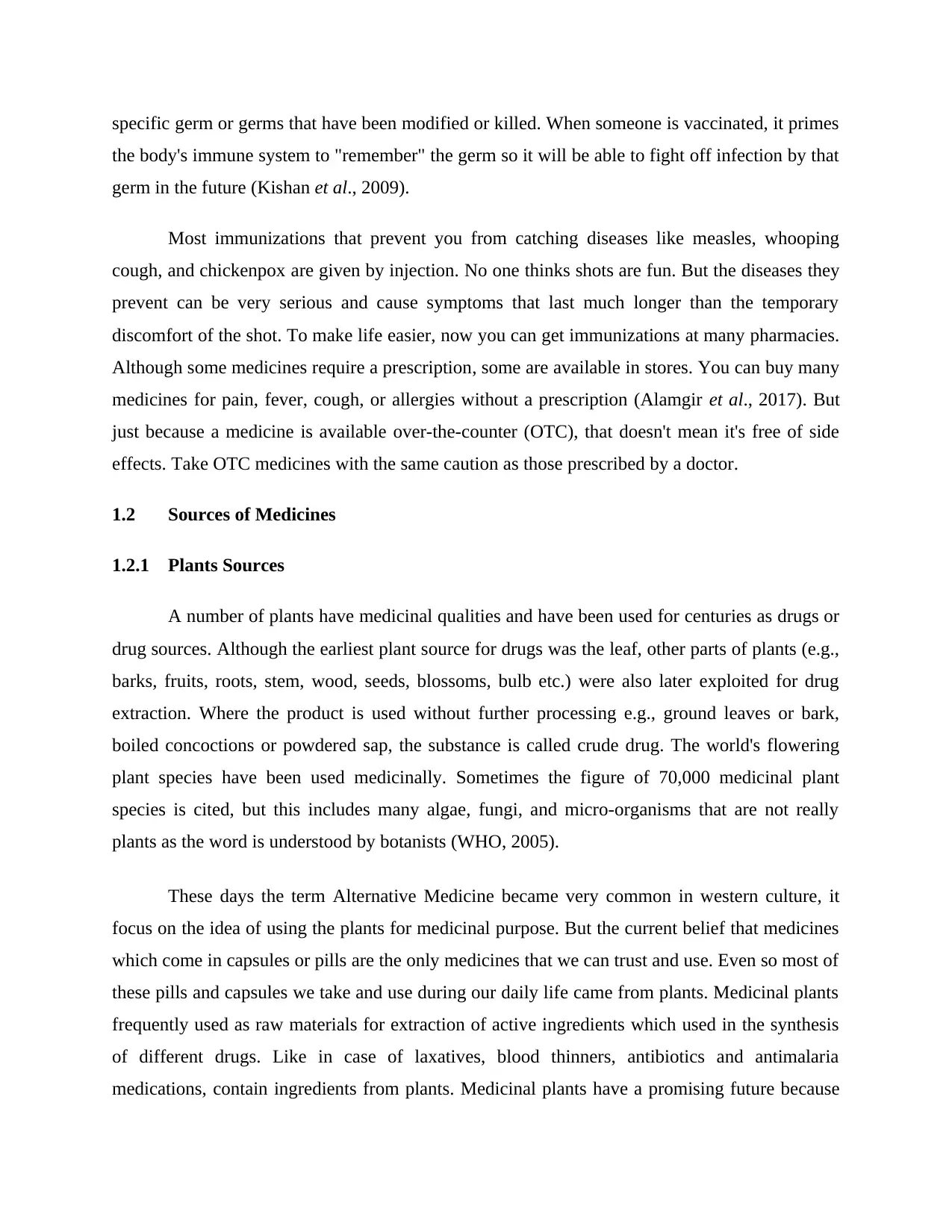
specific germ or germs that have been modified or killed. When someone is vaccinated, it primes
the body's immune system to "remember" the germ so it will be able to fight off infection by that
germ in the future (Kishan et al., 2009).
Most immunizations that prevent you from catching diseases like measles, whooping
cough, and chickenpox are given by injection. No one thinks shots are fun. But the diseases they
prevent can be very serious and cause symptoms that last much longer than the temporary
discomfort of the shot. To make life easier, now you can get immunizations at many pharmacies.
Although some medicines require a prescription, some are available in stores. You can buy many
medicines for pain, fever, cough, or allergies without a prescription (Alamgir et al., 2017). But
just because a medicine is available over-the-counter (OTC), that doesn't mean it's free of side
effects. Take OTC medicines with the same caution as those prescribed by a doctor.
1.2 Sources of Medicines
1.2.1 Plants Sources
A number of plants have medicinal qualities and have been used for centuries as drugs or
drug sources. Although the earliest plant source for drugs was the leaf, other parts of plants (e.g.,
barks, fruits, roots, stem, wood, seeds, blossoms, bulb etc.) were also later exploited for drug
extraction. Where the product is used without further processing e.g., ground leaves or bark,
boiled concoctions or powdered sap, the substance is called crude drug. The world's flowering
plant species have been used medicinally. Sometimes the figure of 70,000 medicinal plant
species is cited, but this includes many algae, fungi, and micro-organisms that are not really
plants as the word is understood by botanists (WHO, 2005).
These days the term Alternative Medicine became very common in western culture, it
focus on the idea of using the plants for medicinal purpose. But the current belief that medicines
which come in capsules or pills are the only medicines that we can trust and use. Even so most of
these pills and capsules we take and use during our daily life came from plants. Medicinal plants
frequently used as raw materials for extraction of active ingredients which used in the synthesis
of different drugs. Like in case of laxatives, blood thinners, antibiotics and antimalaria
medications, contain ingredients from plants. Medicinal plants have a promising future because
the body's immune system to "remember" the germ so it will be able to fight off infection by that
germ in the future (Kishan et al., 2009).
Most immunizations that prevent you from catching diseases like measles, whooping
cough, and chickenpox are given by injection. No one thinks shots are fun. But the diseases they
prevent can be very serious and cause symptoms that last much longer than the temporary
discomfort of the shot. To make life easier, now you can get immunizations at many pharmacies.
Although some medicines require a prescription, some are available in stores. You can buy many
medicines for pain, fever, cough, or allergies without a prescription (Alamgir et al., 2017). But
just because a medicine is available over-the-counter (OTC), that doesn't mean it's free of side
effects. Take OTC medicines with the same caution as those prescribed by a doctor.
1.2 Sources of Medicines
1.2.1 Plants Sources
A number of plants have medicinal qualities and have been used for centuries as drugs or
drug sources. Although the earliest plant source for drugs was the leaf, other parts of plants (e.g.,
barks, fruits, roots, stem, wood, seeds, blossoms, bulb etc.) were also later exploited for drug
extraction. Where the product is used without further processing e.g., ground leaves or bark,
boiled concoctions or powdered sap, the substance is called crude drug. The world's flowering
plant species have been used medicinally. Sometimes the figure of 70,000 medicinal plant
species is cited, but this includes many algae, fungi, and micro-organisms that are not really
plants as the word is understood by botanists (WHO, 2005).
These days the term Alternative Medicine became very common in western culture, it
focus on the idea of using the plants for medicinal purpose. But the current belief that medicines
which come in capsules or pills are the only medicines that we can trust and use. Even so most of
these pills and capsules we take and use during our daily life came from plants. Medicinal plants
frequently used as raw materials for extraction of active ingredients which used in the synthesis
of different drugs. Like in case of laxatives, blood thinners, antibiotics and antimalaria
medications, contain ingredients from plants. Medicinal plants have a promising future because
⊘ This is a preview!⊘
Do you want full access?
Subscribe today to unlock all pages.

Trusted by 1+ million students worldwide
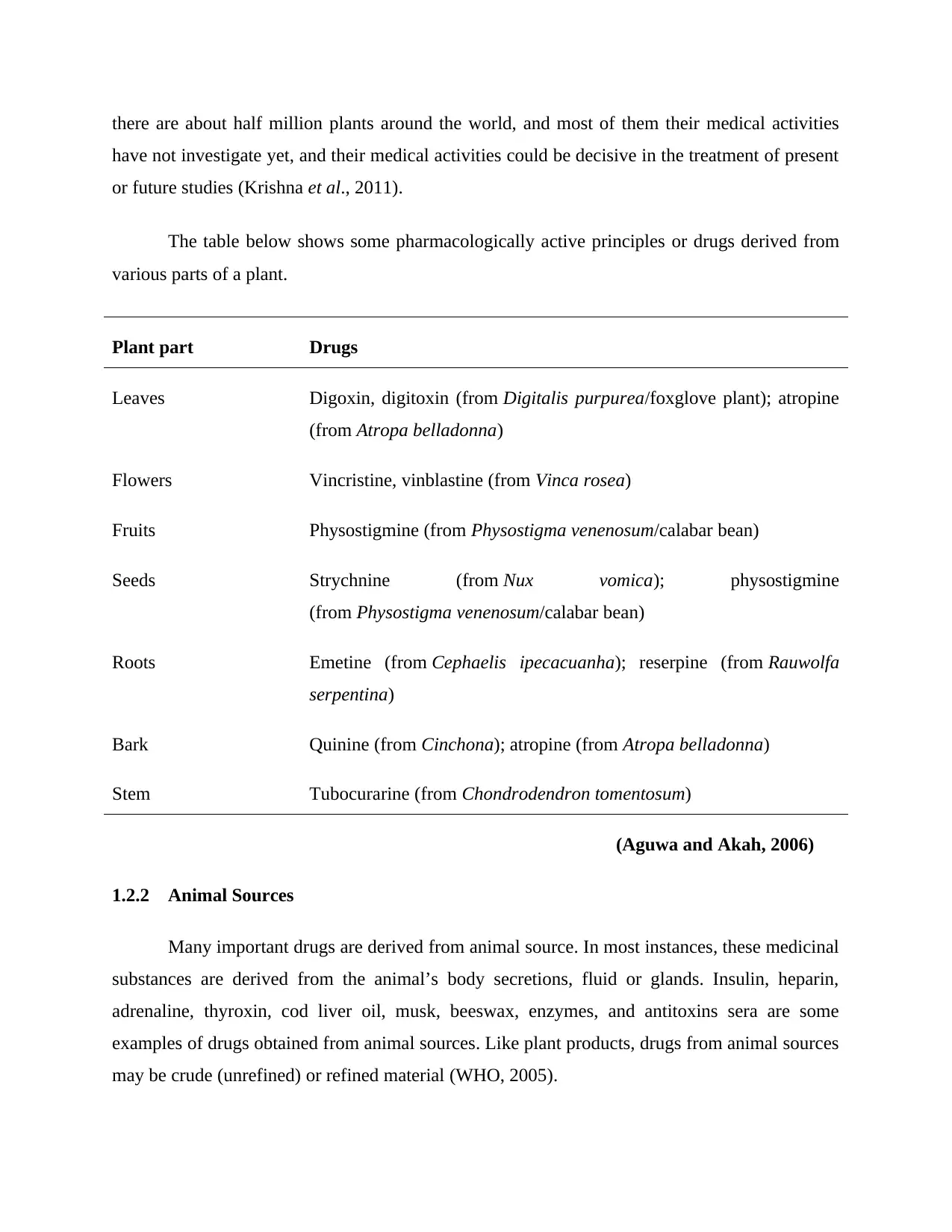
there are about half million plants around the world, and most of them their medical activities
have not investigate yet, and their medical activities could be decisive in the treatment of present
or future studies (Krishna et al., 2011).
The table below shows some pharmacologically active principles or drugs derived from
various parts of a plant.
Plant part Drugs
Leaves Digoxin, digitoxin (from Digitalis purpurea/foxglove plant); atropine
(from Atropa belladonna)
Flowers Vincristine, vinblastine (from Vinca rosea)
Fruits Physostigmine (from Physostigma venenosum/calabar bean)
Seeds Strychnine (from Nux vomica); physostigmine
(from Physostigma venenosum/calabar bean)
Roots Emetine (from Cephaelis ipecacuanha); reserpine (from Rauwolfa
serpentina)
Bark Quinine (from Cinchona); atropine (from Atropa belladonna)
Stem Tubocurarine (from Chondrodendron tomentosum)
(Aguwa and Akah, 2006)
1.2.2 Animal Sources
Many important drugs are derived from animal source. In most instances, these medicinal
substances are derived from the animal’s body secretions, fluid or glands. Insulin, heparin,
adrenaline, thyroxin, cod liver oil, musk, beeswax, enzymes, and antitoxins sera are some
examples of drugs obtained from animal sources. Like plant products, drugs from animal sources
may be crude (unrefined) or refined material (WHO, 2005).
have not investigate yet, and their medical activities could be decisive in the treatment of present
or future studies (Krishna et al., 2011).
The table below shows some pharmacologically active principles or drugs derived from
various parts of a plant.
Plant part Drugs
Leaves Digoxin, digitoxin (from Digitalis purpurea/foxglove plant); atropine
(from Atropa belladonna)
Flowers Vincristine, vinblastine (from Vinca rosea)
Fruits Physostigmine (from Physostigma venenosum/calabar bean)
Seeds Strychnine (from Nux vomica); physostigmine
(from Physostigma venenosum/calabar bean)
Roots Emetine (from Cephaelis ipecacuanha); reserpine (from Rauwolfa
serpentina)
Bark Quinine (from Cinchona); atropine (from Atropa belladonna)
Stem Tubocurarine (from Chondrodendron tomentosum)
(Aguwa and Akah, 2006)
1.2.2 Animal Sources
Many important drugs are derived from animal source. In most instances, these medicinal
substances are derived from the animal’s body secretions, fluid or glands. Insulin, heparin,
adrenaline, thyroxin, cod liver oil, musk, beeswax, enzymes, and antitoxins sera are some
examples of drugs obtained from animal sources. Like plant products, drugs from animal sources
may be crude (unrefined) or refined material (WHO, 2005).
Paraphrase This Document
Need a fresh take? Get an instant paraphrase of this document with our AI Paraphraser
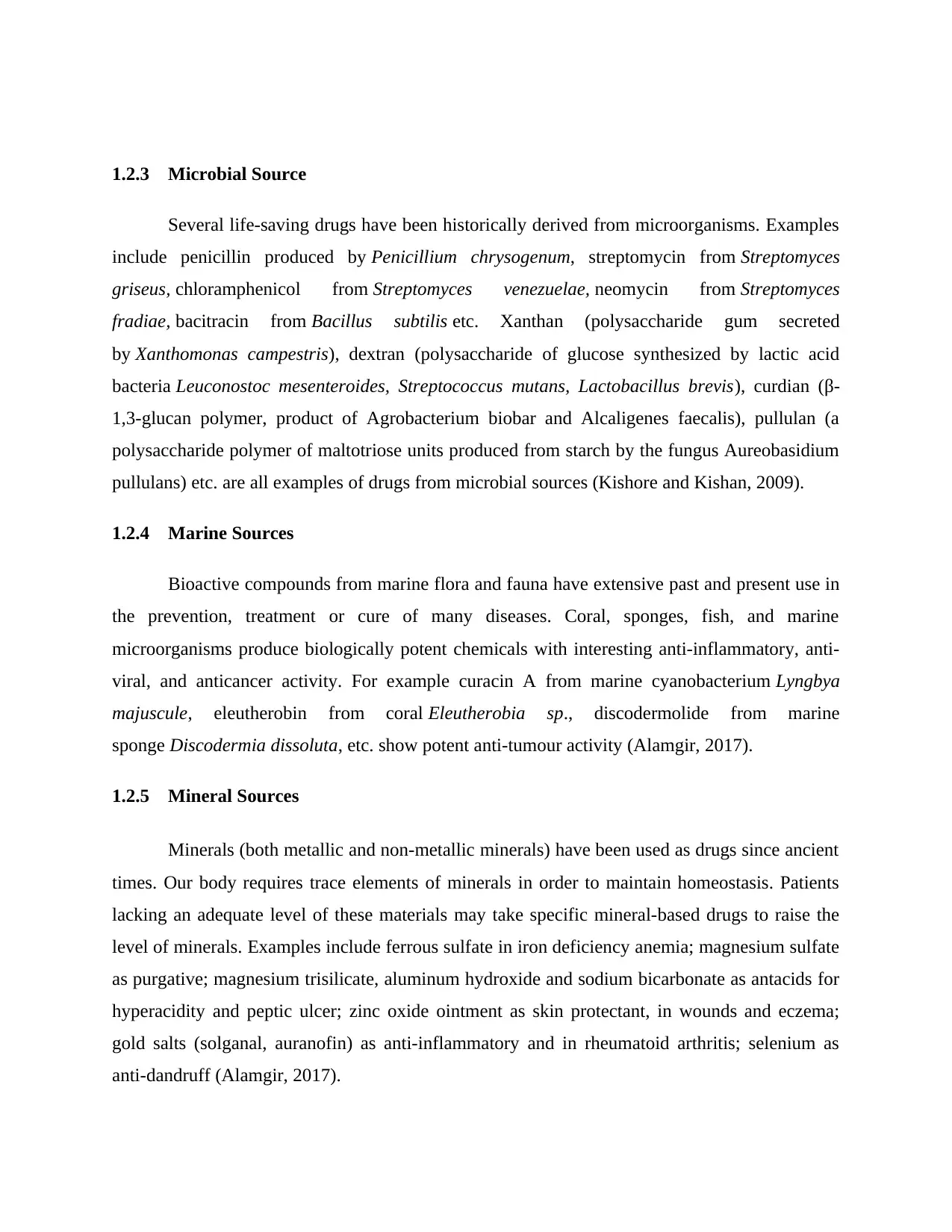
1.2.3 Microbial Source
Several life-saving drugs have been historically derived from microorganisms. Examples
include penicillin produced by Penicillium chrysogenum, streptomycin from Streptomyces
griseus, chloramphenicol from Streptomyces venezuelae, neomycin from Streptomyces
fradiae, bacitracin from Bacillus subtilis etc. Xanthan (polysaccharide gum secreted
by Xanthomonas campestris), dextran (polysaccharide of glucose synthesized by lactic acid
bacteria Leuconostoc mesenteroides, Streptococcus mutans, Lactobacillus brevis), curdian (β-
1,3-glucan polymer, product of Agrobacterium biobar and Alcaligenes faecalis), pullulan (a
polysaccharide polymer of maltotriose units produced from starch by the fungus Aureobasidium
pullulans) etc. are all examples of drugs from microbial sources (Kishore and Kishan, 2009).
1.2.4 Marine Sources
Bioactive compounds from marine flora and fauna have extensive past and present use in
the prevention, treatment or cure of many diseases. Coral, sponges, fish, and marine
microorganisms produce biologically potent chemicals with interesting anti-inflammatory, anti-
viral, and anticancer activity. For example curacin A from marine cyanobacterium Lyngbya
majuscule, eleutherobin from coral Eleutherobia sp., discodermolide from marine
sponge Discodermia dissoluta, etc. show potent anti-tumour activity (Alamgir, 2017).
1.2.5 Mineral Sources
Minerals (both metallic and non-metallic minerals) have been used as drugs since ancient
times. Our body requires trace elements of minerals in order to maintain homeostasis. Patients
lacking an adequate level of these materials may take specific mineral-based drugs to raise the
level of minerals. Examples include ferrous sulfate in iron deficiency anemia; magnesium sulfate
as purgative; magnesium trisilicate, aluminum hydroxide and sodium bicarbonate as antacids for
hyperacidity and peptic ulcer; zinc oxide ointment as skin protectant, in wounds and eczema;
gold salts (solganal, auranofin) as anti-inflammatory and in rheumatoid arthritis; selenium as
anti-dandruff (Alamgir, 2017).
Several life-saving drugs have been historically derived from microorganisms. Examples
include penicillin produced by Penicillium chrysogenum, streptomycin from Streptomyces
griseus, chloramphenicol from Streptomyces venezuelae, neomycin from Streptomyces
fradiae, bacitracin from Bacillus subtilis etc. Xanthan (polysaccharide gum secreted
by Xanthomonas campestris), dextran (polysaccharide of glucose synthesized by lactic acid
bacteria Leuconostoc mesenteroides, Streptococcus mutans, Lactobacillus brevis), curdian (β-
1,3-glucan polymer, product of Agrobacterium biobar and Alcaligenes faecalis), pullulan (a
polysaccharide polymer of maltotriose units produced from starch by the fungus Aureobasidium
pullulans) etc. are all examples of drugs from microbial sources (Kishore and Kishan, 2009).
1.2.4 Marine Sources
Bioactive compounds from marine flora and fauna have extensive past and present use in
the prevention, treatment or cure of many diseases. Coral, sponges, fish, and marine
microorganisms produce biologically potent chemicals with interesting anti-inflammatory, anti-
viral, and anticancer activity. For example curacin A from marine cyanobacterium Lyngbya
majuscule, eleutherobin from coral Eleutherobia sp., discodermolide from marine
sponge Discodermia dissoluta, etc. show potent anti-tumour activity (Alamgir, 2017).
1.2.5 Mineral Sources
Minerals (both metallic and non-metallic minerals) have been used as drugs since ancient
times. Our body requires trace elements of minerals in order to maintain homeostasis. Patients
lacking an adequate level of these materials may take specific mineral-based drugs to raise the
level of minerals. Examples include ferrous sulfate in iron deficiency anemia; magnesium sulfate
as purgative; magnesium trisilicate, aluminum hydroxide and sodium bicarbonate as antacids for
hyperacidity and peptic ulcer; zinc oxide ointment as skin protectant, in wounds and eczema;
gold salts (solganal, auranofin) as anti-inflammatory and in rheumatoid arthritis; selenium as
anti-dandruff (Alamgir, 2017).
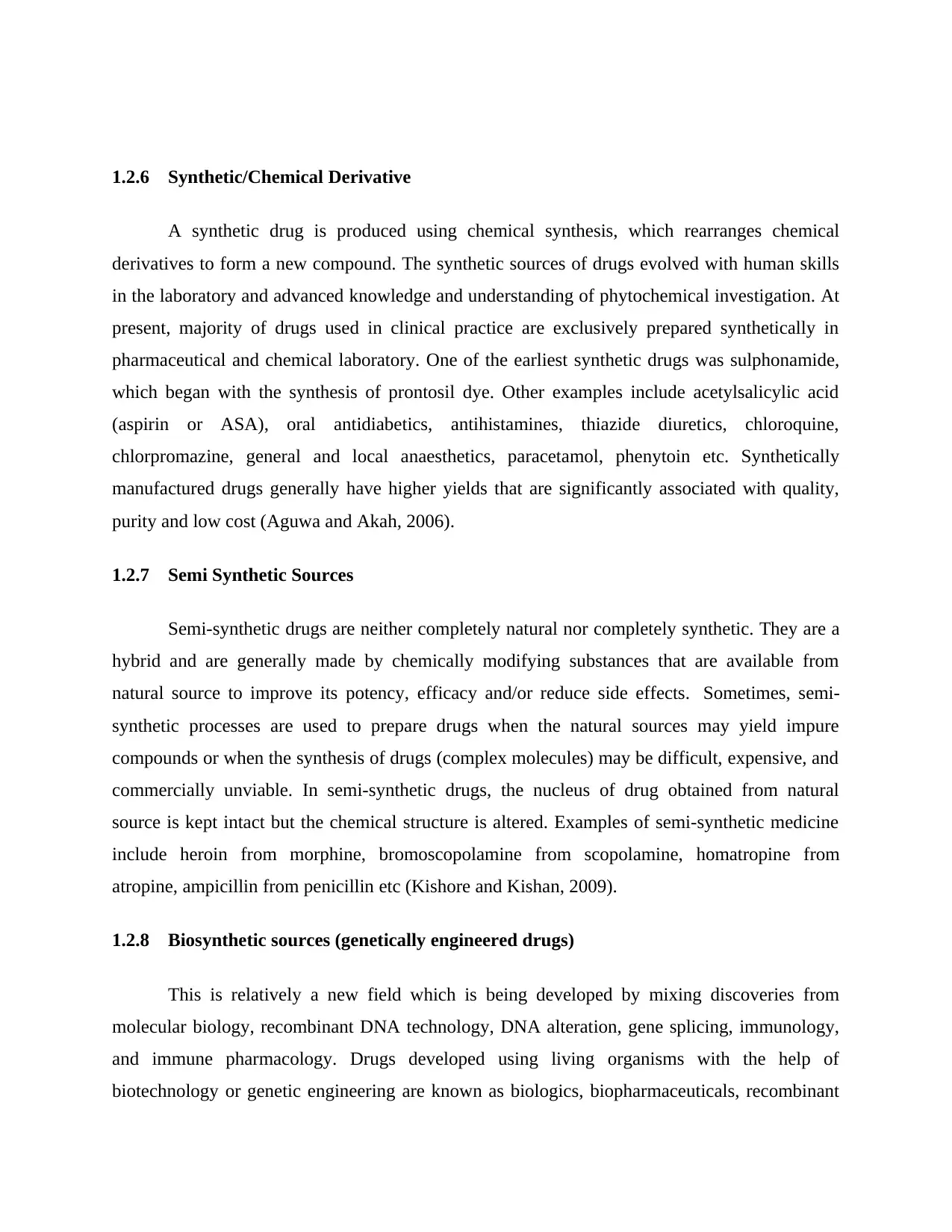
1.2.6 Synthetic/Chemical Derivative
A synthetic drug is produced using chemical synthesis, which rearranges chemical
derivatives to form a new compound. The synthetic sources of drugs evolved with human skills
in the laboratory and advanced knowledge and understanding of phytochemical investigation. At
present, majority of drugs used in clinical practice are exclusively prepared synthetically in
pharmaceutical and chemical laboratory. One of the earliest synthetic drugs was sulphonamide,
which began with the synthesis of prontosil dye. Other examples include acetylsalicylic acid
(aspirin or ASA), oral antidiabetics, antihistamines, thiazide diuretics, chloroquine,
chlorpromazine, general and local anaesthetics, paracetamol, phenytoin etc. Synthetically
manufactured drugs generally have higher yields that are significantly associated with quality,
purity and low cost (Aguwa and Akah, 2006).
1.2.7 Semi Synthetic Sources
Semi-synthetic drugs are neither completely natural nor completely synthetic. They are a
hybrid and are generally made by chemically modifying substances that are available from
natural source to improve its potency, efficacy and/or reduce side effects. Sometimes, semi-
synthetic processes are used to prepare drugs when the natural sources may yield impure
compounds or when the synthesis of drugs (complex molecules) may be difficult, expensive, and
commercially unviable. In semi-synthetic drugs, the nucleus of drug obtained from natural
source is kept intact but the chemical structure is altered. Examples of semi-synthetic medicine
include heroin from morphine, bromoscopolamine from scopolamine, homatropine from
atropine, ampicillin from penicillin etc (Kishore and Kishan, 2009).
1.2.8 Biosynthetic sources (genetically engineered drugs)
This is relatively a new field which is being developed by mixing discoveries from
molecular biology, recombinant DNA technology, DNA alteration, gene splicing, immunology,
and immune pharmacology. Drugs developed using living organisms with the help of
biotechnology or genetic engineering are known as biologics, biopharmaceuticals, recombinant
A synthetic drug is produced using chemical synthesis, which rearranges chemical
derivatives to form a new compound. The synthetic sources of drugs evolved with human skills
in the laboratory and advanced knowledge and understanding of phytochemical investigation. At
present, majority of drugs used in clinical practice are exclusively prepared synthetically in
pharmaceutical and chemical laboratory. One of the earliest synthetic drugs was sulphonamide,
which began with the synthesis of prontosil dye. Other examples include acetylsalicylic acid
(aspirin or ASA), oral antidiabetics, antihistamines, thiazide diuretics, chloroquine,
chlorpromazine, general and local anaesthetics, paracetamol, phenytoin etc. Synthetically
manufactured drugs generally have higher yields that are significantly associated with quality,
purity and low cost (Aguwa and Akah, 2006).
1.2.7 Semi Synthetic Sources
Semi-synthetic drugs are neither completely natural nor completely synthetic. They are a
hybrid and are generally made by chemically modifying substances that are available from
natural source to improve its potency, efficacy and/or reduce side effects. Sometimes, semi-
synthetic processes are used to prepare drugs when the natural sources may yield impure
compounds or when the synthesis of drugs (complex molecules) may be difficult, expensive, and
commercially unviable. In semi-synthetic drugs, the nucleus of drug obtained from natural
source is kept intact but the chemical structure is altered. Examples of semi-synthetic medicine
include heroin from morphine, bromoscopolamine from scopolamine, homatropine from
atropine, ampicillin from penicillin etc (Kishore and Kishan, 2009).
1.2.8 Biosynthetic sources (genetically engineered drugs)
This is relatively a new field which is being developed by mixing discoveries from
molecular biology, recombinant DNA technology, DNA alteration, gene splicing, immunology,
and immune pharmacology. Drugs developed using living organisms with the help of
biotechnology or genetic engineering are known as biologics, biopharmaceuticals, recombinant
⊘ This is a preview!⊘
Do you want full access?
Subscribe today to unlock all pages.

Trusted by 1+ million students worldwide
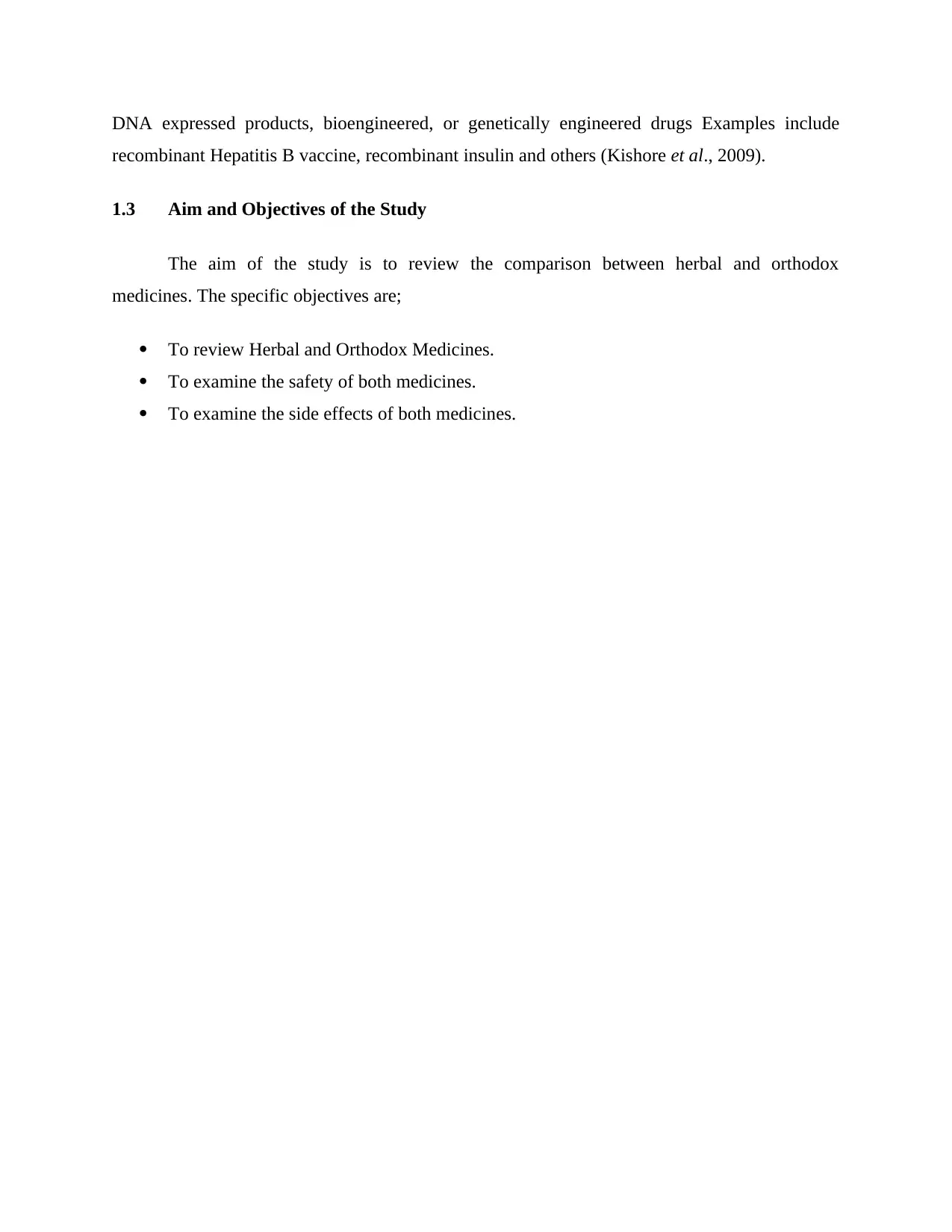
DNA expressed products, bioengineered, or genetically engineered drugs Examples include
recombinant Hepatitis B vaccine, recombinant insulin and others (Kishore et al., 2009).
1.3 Aim and Objectives of the Study
The aim of the study is to review the comparison between herbal and orthodox
medicines. The specific objectives are;
To review Herbal and Orthodox Medicines.
To examine the safety of both medicines.
To examine the side effects of both medicines.
recombinant Hepatitis B vaccine, recombinant insulin and others (Kishore et al., 2009).
1.3 Aim and Objectives of the Study
The aim of the study is to review the comparison between herbal and orthodox
medicines. The specific objectives are;
To review Herbal and Orthodox Medicines.
To examine the safety of both medicines.
To examine the side effects of both medicines.
Paraphrase This Document
Need a fresh take? Get an instant paraphrase of this document with our AI Paraphraser
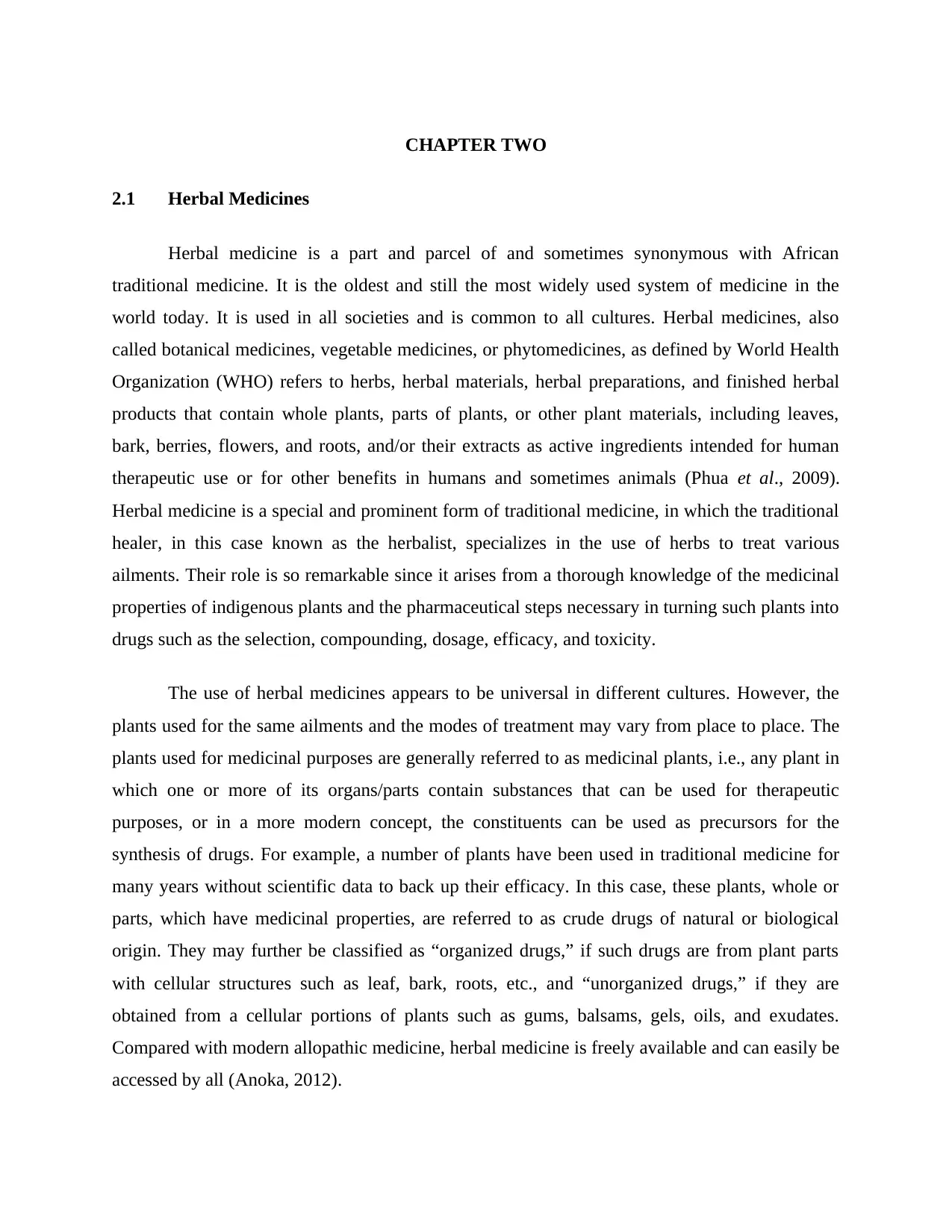
CHAPTER TWO
2.1 Herbal Medicines
Herbal medicine is a part and parcel of and sometimes synonymous with African
traditional medicine. It is the oldest and still the most widely used system of medicine in the
world today. It is used in all societies and is common to all cultures. Herbal medicines, also
called botanical medicines, vegetable medicines, or phytomedicines, as defined by World Health
Organization (WHO) refers to herbs, herbal materials, herbal preparations, and finished herbal
products that contain whole plants, parts of plants, or other plant materials, including leaves,
bark, berries, flowers, and roots, and/or their extracts as active ingredients intended for human
therapeutic use or for other benefits in humans and sometimes animals (Phua et al., 2009).
Herbal medicine is a special and prominent form of traditional medicine, in which the traditional
healer, in this case known as the herbalist, specializes in the use of herbs to treat various
ailments. Their role is so remarkable since it arises from a thorough knowledge of the medicinal
properties of indigenous plants and the pharmaceutical steps necessary in turning such plants into
drugs such as the selection, compounding, dosage, efficacy, and toxicity.
The use of herbal medicines appears to be universal in different cultures. However, the
plants used for the same ailments and the modes of treatment may vary from place to place. The
plants used for medicinal purposes are generally referred to as medicinal plants, i.e., any plant in
which one or more of its organs/parts contain substances that can be used for therapeutic
purposes, or in a more modern concept, the constituents can be used as precursors for the
synthesis of drugs. For example, a number of plants have been used in traditional medicine for
many years without scientific data to back up their efficacy. In this case, these plants, whole or
parts, which have medicinal properties, are referred to as crude drugs of natural or biological
origin. They may further be classified as “organized drugs,” if such drugs are from plant parts
with cellular structures such as leaf, bark, roots, etc., and “unorganized drugs,” if they are
obtained from a cellular portions of plants such as gums, balsams, gels, oils, and exudates.
Compared with modern allopathic medicine, herbal medicine is freely available and can easily be
accessed by all (Anoka, 2012).
2.1 Herbal Medicines
Herbal medicine is a part and parcel of and sometimes synonymous with African
traditional medicine. It is the oldest and still the most widely used system of medicine in the
world today. It is used in all societies and is common to all cultures. Herbal medicines, also
called botanical medicines, vegetable medicines, or phytomedicines, as defined by World Health
Organization (WHO) refers to herbs, herbal materials, herbal preparations, and finished herbal
products that contain whole plants, parts of plants, or other plant materials, including leaves,
bark, berries, flowers, and roots, and/or their extracts as active ingredients intended for human
therapeutic use or for other benefits in humans and sometimes animals (Phua et al., 2009).
Herbal medicine is a special and prominent form of traditional medicine, in which the traditional
healer, in this case known as the herbalist, specializes in the use of herbs to treat various
ailments. Their role is so remarkable since it arises from a thorough knowledge of the medicinal
properties of indigenous plants and the pharmaceutical steps necessary in turning such plants into
drugs such as the selection, compounding, dosage, efficacy, and toxicity.
The use of herbal medicines appears to be universal in different cultures. However, the
plants used for the same ailments and the modes of treatment may vary from place to place. The
plants used for medicinal purposes are generally referred to as medicinal plants, i.e., any plant in
which one or more of its organs/parts contain substances that can be used for therapeutic
purposes, or in a more modern concept, the constituents can be used as precursors for the
synthesis of drugs. For example, a number of plants have been used in traditional medicine for
many years without scientific data to back up their efficacy. In this case, these plants, whole or
parts, which have medicinal properties, are referred to as crude drugs of natural or biological
origin. They may further be classified as “organized drugs,” if such drugs are from plant parts
with cellular structures such as leaf, bark, roots, etc., and “unorganized drugs,” if they are
obtained from a cellular portions of plants such as gums, balsams, gels, oils, and exudates.
Compared with modern allopathic medicine, herbal medicine is freely available and can easily be
accessed by all (Anoka, 2012).
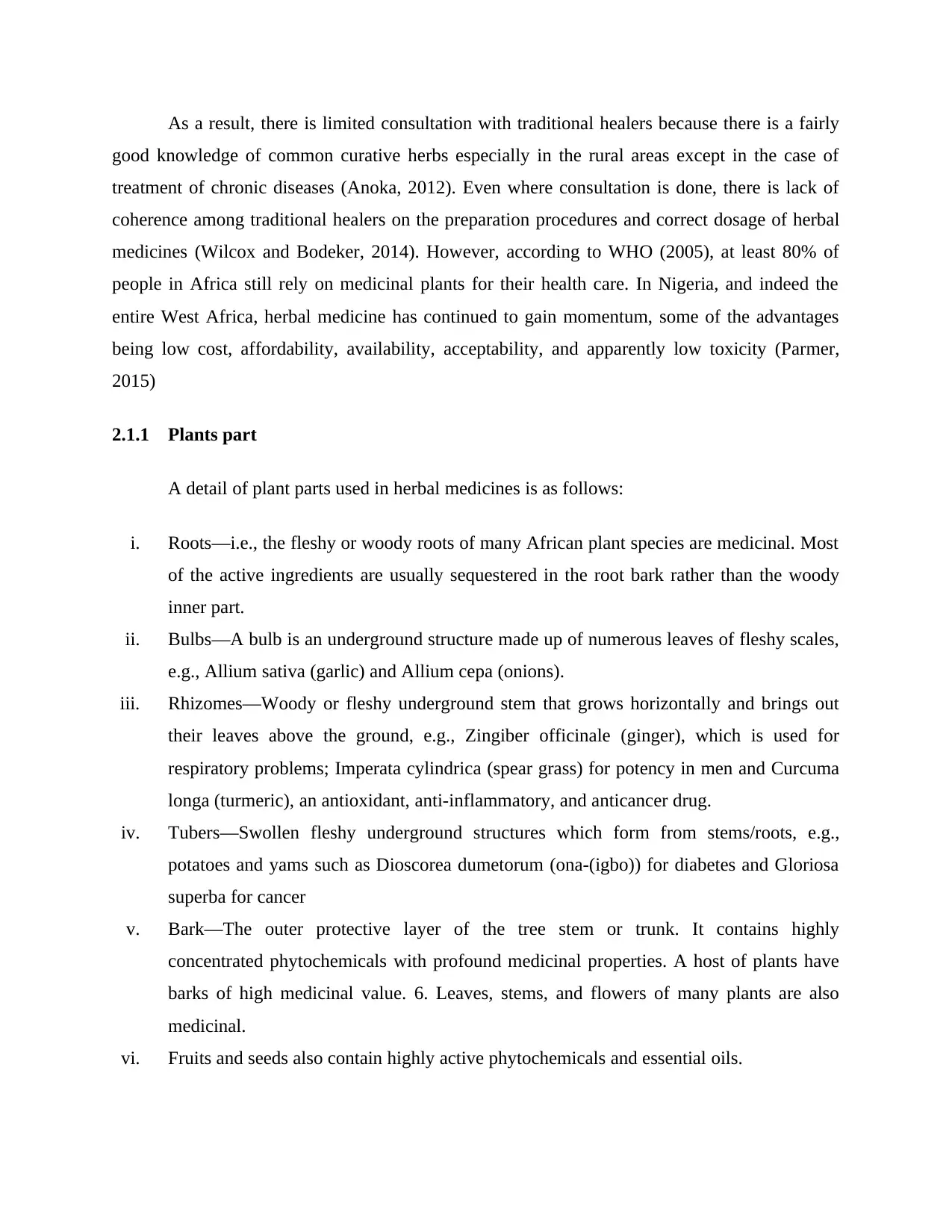
As a result, there is limited consultation with traditional healers because there is a fairly
good knowledge of common curative herbs especially in the rural areas except in the case of
treatment of chronic diseases (Anoka, 2012). Even where consultation is done, there is lack of
coherence among traditional healers on the preparation procedures and correct dosage of herbal
medicines (Wilcox and Bodeker, 2014). However, according to WHO (2005), at least 80% of
people in Africa still rely on medicinal plants for their health care. In Nigeria, and indeed the
entire West Africa, herbal medicine has continued to gain momentum, some of the advantages
being low cost, affordability, availability, acceptability, and apparently low toxicity (Parmer,
2015)
2.1.1 Plants part
A detail of plant parts used in herbal medicines is as follows:
i. Roots—i.e., the fleshy or woody roots of many African plant species are medicinal. Most
of the active ingredients are usually sequestered in the root bark rather than the woody
inner part.
ii. Bulbs—A bulb is an underground structure made up of numerous leaves of fleshy scales,
e.g., Allium sativa (garlic) and Allium cepa (onions).
iii. Rhizomes—Woody or fleshy underground stem that grows horizontally and brings out
their leaves above the ground, e.g., Zingiber officinale (ginger), which is used for
respiratory problems; Imperata cylindrica (spear grass) for potency in men and Curcuma
longa (turmeric), an antioxidant, anti-inflammatory, and anticancer drug.
iv. Tubers—Swollen fleshy underground structures which form from stems/roots, e.g.,
potatoes and yams such as Dioscorea dumetorum (ona-(igbo)) for diabetes and Gloriosa
superba for cancer
v. Bark—The outer protective layer of the tree stem or trunk. It contains highly
concentrated phytochemicals with profound medicinal properties. A host of plants have
barks of high medicinal value. 6. Leaves, stems, and flowers of many plants are also
medicinal.
vi. Fruits and seeds also contain highly active phytochemicals and essential oils.
good knowledge of common curative herbs especially in the rural areas except in the case of
treatment of chronic diseases (Anoka, 2012). Even where consultation is done, there is lack of
coherence among traditional healers on the preparation procedures and correct dosage of herbal
medicines (Wilcox and Bodeker, 2014). However, according to WHO (2005), at least 80% of
people in Africa still rely on medicinal plants for their health care. In Nigeria, and indeed the
entire West Africa, herbal medicine has continued to gain momentum, some of the advantages
being low cost, affordability, availability, acceptability, and apparently low toxicity (Parmer,
2015)
2.1.1 Plants part
A detail of plant parts used in herbal medicines is as follows:
i. Roots—i.e., the fleshy or woody roots of many African plant species are medicinal. Most
of the active ingredients are usually sequestered in the root bark rather than the woody
inner part.
ii. Bulbs—A bulb is an underground structure made up of numerous leaves of fleshy scales,
e.g., Allium sativa (garlic) and Allium cepa (onions).
iii. Rhizomes—Woody or fleshy underground stem that grows horizontally and brings out
their leaves above the ground, e.g., Zingiber officinale (ginger), which is used for
respiratory problems; Imperata cylindrica (spear grass) for potency in men and Curcuma
longa (turmeric), an antioxidant, anti-inflammatory, and anticancer drug.
iv. Tubers—Swollen fleshy underground structures which form from stems/roots, e.g.,
potatoes and yams such as Dioscorea dumetorum (ona-(igbo)) for diabetes and Gloriosa
superba for cancer
v. Bark—The outer protective layer of the tree stem or trunk. It contains highly
concentrated phytochemicals with profound medicinal properties. A host of plants have
barks of high medicinal value. 6. Leaves, stems, and flowers of many plants are also
medicinal.
vi. Fruits and seeds also contain highly active phytochemicals and essential oils.
⊘ This is a preview!⊘
Do you want full access?
Subscribe today to unlock all pages.

Trusted by 1+ million students worldwide
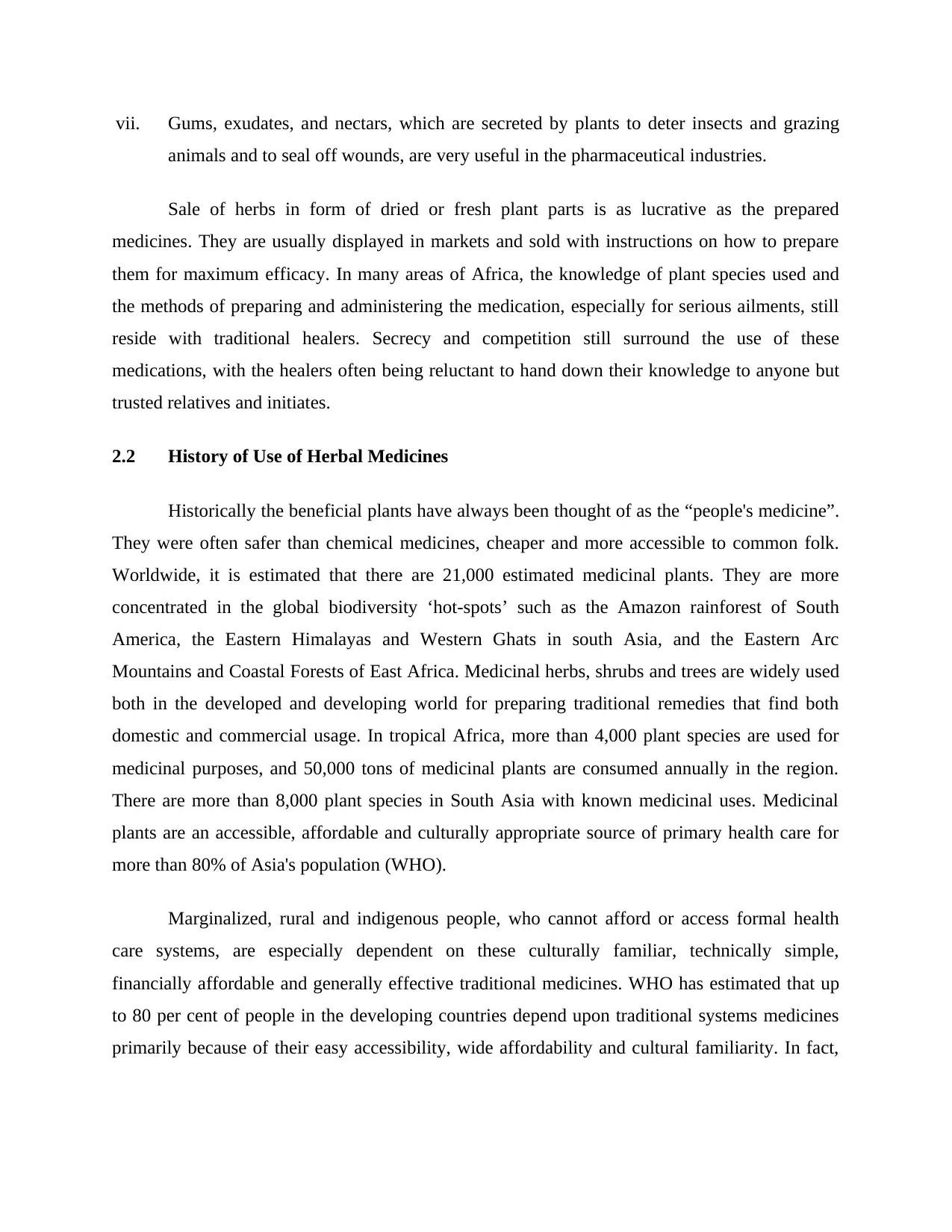
vii. Gums, exudates, and nectars, which are secreted by plants to deter insects and grazing
animals and to seal off wounds, are very useful in the pharmaceutical industries.
Sale of herbs in form of dried or fresh plant parts is as lucrative as the prepared
medicines. They are usually displayed in markets and sold with instructions on how to prepare
them for maximum efficacy. In many areas of Africa, the knowledge of plant species used and
the methods of preparing and administering the medication, especially for serious ailments, still
reside with traditional healers. Secrecy and competition still surround the use of these
medications, with the healers often being reluctant to hand down their knowledge to anyone but
trusted relatives and initiates.
2.2 History of Use of Herbal Medicines
Historically the beneficial plants have always been thought of as the “people's medicine”.
They were often safer than chemical medicines, cheaper and more accessible to common folk.
Worldwide, it is estimated that there are 21,000 estimated medicinal plants. They are more
concentrated in the global biodiversity ‘hot-spots’ such as the Amazon rainforest of South
America, the Eastern Himalayas and Western Ghats in south Asia, and the Eastern Arc
Mountains and Coastal Forests of East Africa. Medicinal herbs, shrubs and trees are widely used
both in the developed and developing world for preparing traditional remedies that find both
domestic and commercial usage. In tropical Africa, more than 4,000 plant species are used for
medicinal purposes, and 50,000 tons of medicinal plants are consumed annually in the region.
There are more than 8,000 plant species in South Asia with known medicinal uses. Medicinal
plants are an accessible, affordable and culturally appropriate source of primary health care for
more than 80% of Asia's population (WHO).
Marginalized, rural and indigenous people, who cannot afford or access formal health
care systems, are especially dependent on these culturally familiar, technically simple,
financially affordable and generally effective traditional medicines. WHO has estimated that up
to 80 per cent of people in the developing countries depend upon traditional systems medicines
primarily because of their easy accessibility, wide affordability and cultural familiarity. In fact,
animals and to seal off wounds, are very useful in the pharmaceutical industries.
Sale of herbs in form of dried or fresh plant parts is as lucrative as the prepared
medicines. They are usually displayed in markets and sold with instructions on how to prepare
them for maximum efficacy. In many areas of Africa, the knowledge of plant species used and
the methods of preparing and administering the medication, especially for serious ailments, still
reside with traditional healers. Secrecy and competition still surround the use of these
medications, with the healers often being reluctant to hand down their knowledge to anyone but
trusted relatives and initiates.
2.2 History of Use of Herbal Medicines
Historically the beneficial plants have always been thought of as the “people's medicine”.
They were often safer than chemical medicines, cheaper and more accessible to common folk.
Worldwide, it is estimated that there are 21,000 estimated medicinal plants. They are more
concentrated in the global biodiversity ‘hot-spots’ such as the Amazon rainforest of South
America, the Eastern Himalayas and Western Ghats in south Asia, and the Eastern Arc
Mountains and Coastal Forests of East Africa. Medicinal herbs, shrubs and trees are widely used
both in the developed and developing world for preparing traditional remedies that find both
domestic and commercial usage. In tropical Africa, more than 4,000 plant species are used for
medicinal purposes, and 50,000 tons of medicinal plants are consumed annually in the region.
There are more than 8,000 plant species in South Asia with known medicinal uses. Medicinal
plants are an accessible, affordable and culturally appropriate source of primary health care for
more than 80% of Asia's population (WHO).
Marginalized, rural and indigenous people, who cannot afford or access formal health
care systems, are especially dependent on these culturally familiar, technically simple,
financially affordable and generally effective traditional medicines. WHO has estimated that up
to 80 per cent of people in the developing countries depend upon traditional systems medicines
primarily because of their easy accessibility, wide affordability and cultural familiarity. In fact,
Paraphrase This Document
Need a fresh take? Get an instant paraphrase of this document with our AI Paraphraser
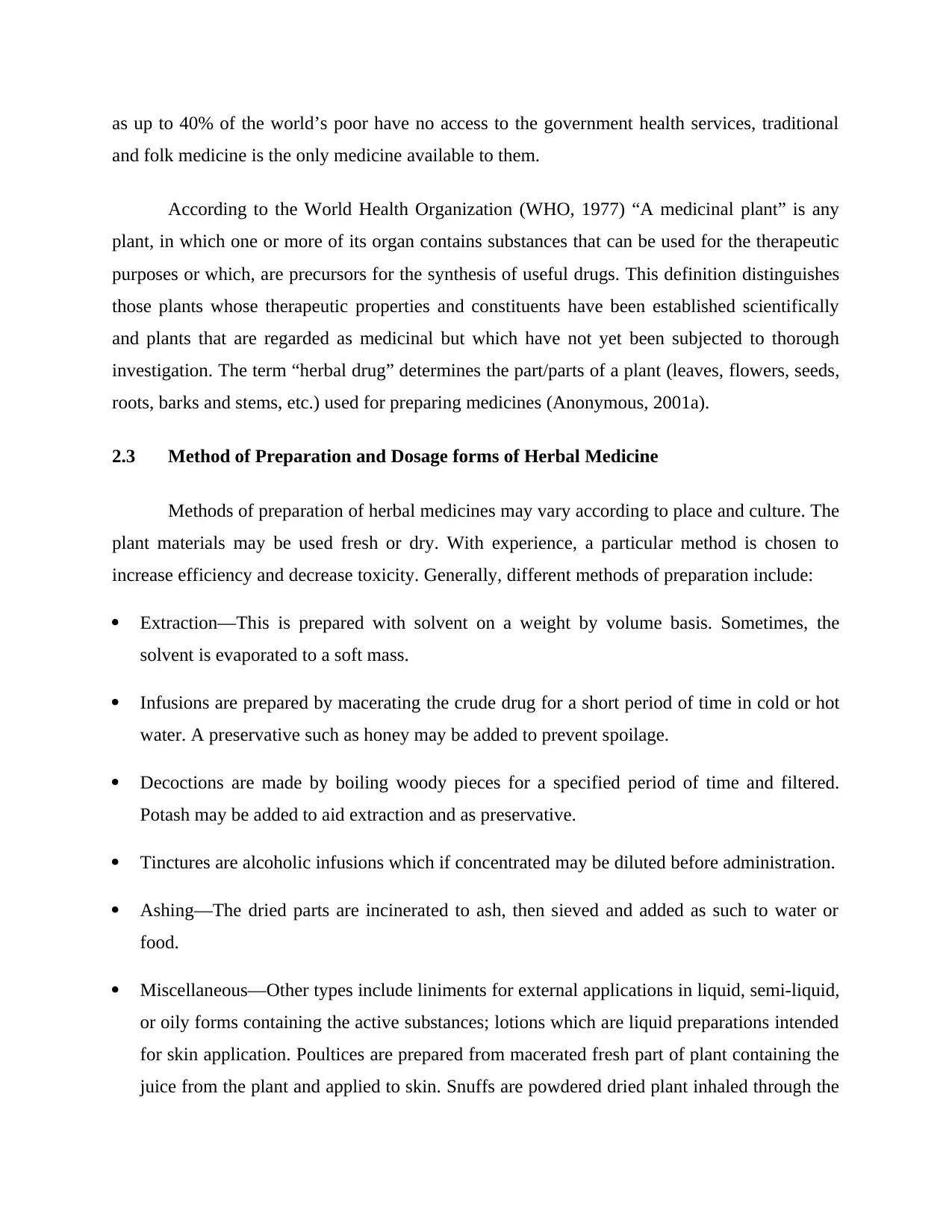
as up to 40% of the world’s poor have no access to the government health services, traditional
and folk medicine is the only medicine available to them.
According to the World Health Organization (WHO, 1977) “A medicinal plant” is any
plant, in which one or more of its organ contains substances that can be used for the therapeutic
purposes or which, are precursors for the synthesis of useful drugs. This definition distinguishes
those plants whose therapeutic properties and constituents have been established scientifically
and plants that are regarded as medicinal but which have not yet been subjected to thorough
investigation. The term “herbal drug” determines the part/parts of a plant (leaves, flowers, seeds,
roots, barks and stems, etc.) used for preparing medicines (Anonymous, 2001a).
2.3 Method of Preparation and Dosage forms of Herbal Medicine
Methods of preparation of herbal medicines may vary according to place and culture. The
plant materials may be used fresh or dry. With experience, a particular method is chosen to
increase efficiency and decrease toxicity. Generally, different methods of preparation include:
Extraction—This is prepared with solvent on a weight by volume basis. Sometimes, the
solvent is evaporated to a soft mass.
Infusions are prepared by macerating the crude drug for a short period of time in cold or hot
water. A preservative such as honey may be added to prevent spoilage.
Decoctions are made by boiling woody pieces for a specified period of time and filtered.
Potash may be added to aid extraction and as preservative.
Tinctures are alcoholic infusions which if concentrated may be diluted before administration.
Ashing—The dried parts are incinerated to ash, then sieved and added as such to water or
food.
Miscellaneous—Other types include liniments for external applications in liquid, semi-liquid,
or oily forms containing the active substances; lotions which are liquid preparations intended
for skin application. Poultices are prepared from macerated fresh part of plant containing the
juice from the plant and applied to skin. Snuffs are powdered dried plant inhaled through the
and folk medicine is the only medicine available to them.
According to the World Health Organization (WHO, 1977) “A medicinal plant” is any
plant, in which one or more of its organ contains substances that can be used for the therapeutic
purposes or which, are precursors for the synthesis of useful drugs. This definition distinguishes
those plants whose therapeutic properties and constituents have been established scientifically
and plants that are regarded as medicinal but which have not yet been subjected to thorough
investigation. The term “herbal drug” determines the part/parts of a plant (leaves, flowers, seeds,
roots, barks and stems, etc.) used for preparing medicines (Anonymous, 2001a).
2.3 Method of Preparation and Dosage forms of Herbal Medicine
Methods of preparation of herbal medicines may vary according to place and culture. The
plant materials may be used fresh or dry. With experience, a particular method is chosen to
increase efficiency and decrease toxicity. Generally, different methods of preparation include:
Extraction—This is prepared with solvent on a weight by volume basis. Sometimes, the
solvent is evaporated to a soft mass.
Infusions are prepared by macerating the crude drug for a short period of time in cold or hot
water. A preservative such as honey may be added to prevent spoilage.
Decoctions are made by boiling woody pieces for a specified period of time and filtered.
Potash may be added to aid extraction and as preservative.
Tinctures are alcoholic infusions which if concentrated may be diluted before administration.
Ashing—The dried parts are incinerated to ash, then sieved and added as such to water or
food.
Miscellaneous—Other types include liniments for external applications in liquid, semi-liquid,
or oily forms containing the active substances; lotions which are liquid preparations intended
for skin application. Poultices are prepared from macerated fresh part of plant containing the
juice from the plant and applied to skin. Snuffs are powdered dried plant inhaled through the
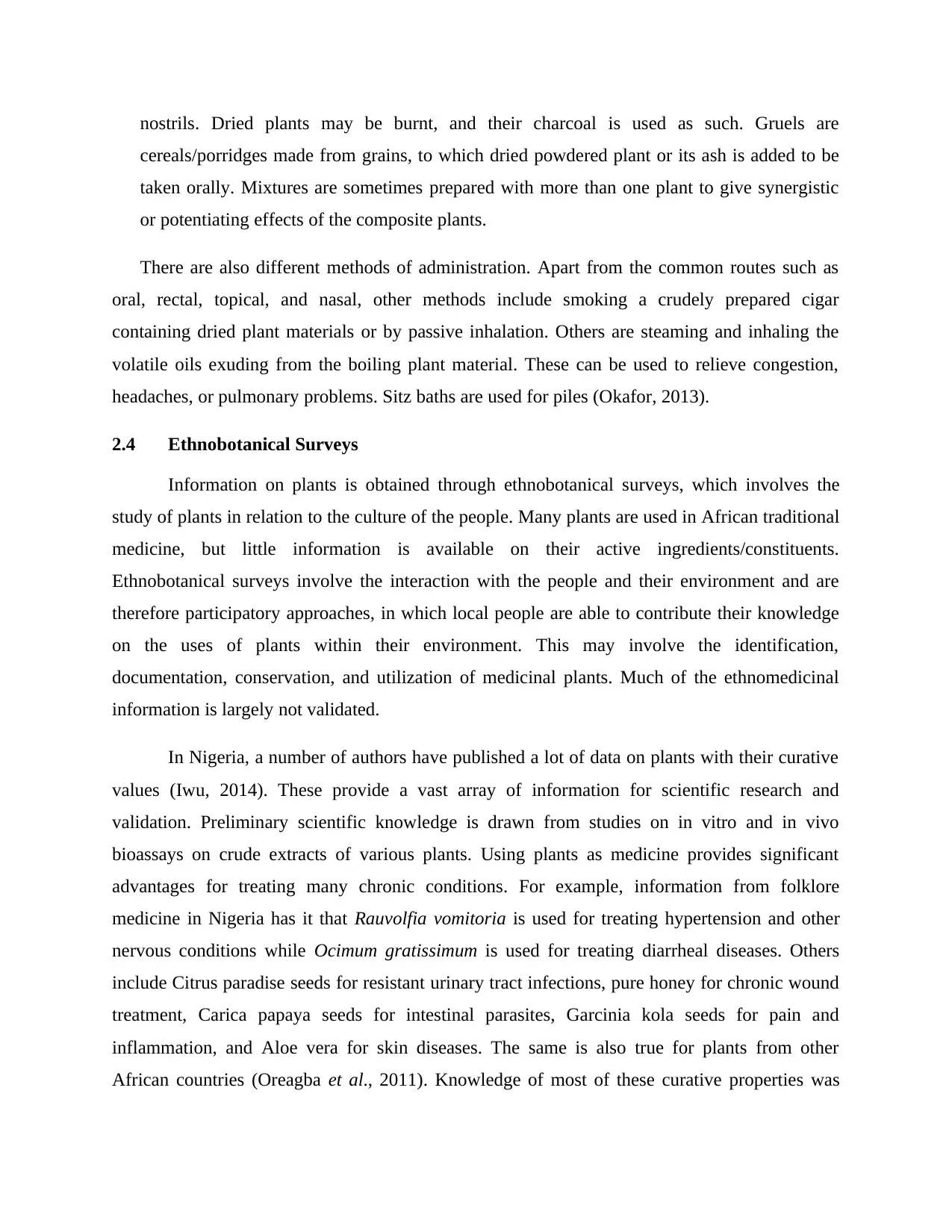
nostrils. Dried plants may be burnt, and their charcoal is used as such. Gruels are
cereals/porridges made from grains, to which dried powdered plant or its ash is added to be
taken orally. Mixtures are sometimes prepared with more than one plant to give synergistic
or potentiating effects of the composite plants.
There are also different methods of administration. Apart from the common routes such as
oral, rectal, topical, and nasal, other methods include smoking a crudely prepared cigar
containing dried plant materials or by passive inhalation. Others are steaming and inhaling the
volatile oils exuding from the boiling plant material. These can be used to relieve congestion,
headaches, or pulmonary problems. Sitz baths are used for piles (Okafor, 2013).
2.4 Ethnobotanical Surveys
Information on plants is obtained through ethnobotanical surveys, which involves the
study of plants in relation to the culture of the people. Many plants are used in African traditional
medicine, but little information is available on their active ingredients/constituents.
Ethnobotanical surveys involve the interaction with the people and their environment and are
therefore participatory approaches, in which local people are able to contribute their knowledge
on the uses of plants within their environment. This may involve the identification,
documentation, conservation, and utilization of medicinal plants. Much of the ethnomedicinal
information is largely not validated.
In Nigeria, a number of authors have published a lot of data on plants with their curative
values (Iwu, 2014). These provide a vast array of information for scientific research and
validation. Preliminary scientific knowledge is drawn from studies on in vitro and in vivo
bioassays on crude extracts of various plants. Using plants as medicine provides significant
advantages for treating many chronic conditions. For example, information from folklore
medicine in Nigeria has it that Rauvolfia vomitoria is used for treating hypertension and other
nervous conditions while Ocimum gratissimum is used for treating diarrheal diseases. Others
include Citrus paradise seeds for resistant urinary tract infections, pure honey for chronic wound
treatment, Carica papaya seeds for intestinal parasites, Garcinia kola seeds for pain and
inflammation, and Aloe vera for skin diseases. The same is also true for plants from other
African countries (Oreagba et al., 2011). Knowledge of most of these curative properties was
cereals/porridges made from grains, to which dried powdered plant or its ash is added to be
taken orally. Mixtures are sometimes prepared with more than one plant to give synergistic
or potentiating effects of the composite plants.
There are also different methods of administration. Apart from the common routes such as
oral, rectal, topical, and nasal, other methods include smoking a crudely prepared cigar
containing dried plant materials or by passive inhalation. Others are steaming and inhaling the
volatile oils exuding from the boiling plant material. These can be used to relieve congestion,
headaches, or pulmonary problems. Sitz baths are used for piles (Okafor, 2013).
2.4 Ethnobotanical Surveys
Information on plants is obtained through ethnobotanical surveys, which involves the
study of plants in relation to the culture of the people. Many plants are used in African traditional
medicine, but little information is available on their active ingredients/constituents.
Ethnobotanical surveys involve the interaction with the people and their environment and are
therefore participatory approaches, in which local people are able to contribute their knowledge
on the uses of plants within their environment. This may involve the identification,
documentation, conservation, and utilization of medicinal plants. Much of the ethnomedicinal
information is largely not validated.
In Nigeria, a number of authors have published a lot of data on plants with their curative
values (Iwu, 2014). These provide a vast array of information for scientific research and
validation. Preliminary scientific knowledge is drawn from studies on in vitro and in vivo
bioassays on crude extracts of various plants. Using plants as medicine provides significant
advantages for treating many chronic conditions. For example, information from folklore
medicine in Nigeria has it that Rauvolfia vomitoria is used for treating hypertension and other
nervous conditions while Ocimum gratissimum is used for treating diarrheal diseases. Others
include Citrus paradise seeds for resistant urinary tract infections, pure honey for chronic wound
treatment, Carica papaya seeds for intestinal parasites, Garcinia kola seeds for pain and
inflammation, and Aloe vera for skin diseases. The same is also true for plants from other
African countries (Oreagba et al., 2011). Knowledge of most of these curative properties was
⊘ This is a preview!⊘
Do you want full access?
Subscribe today to unlock all pages.

Trusted by 1+ million students worldwide
1 out of 25
Related Documents
Your All-in-One AI-Powered Toolkit for Academic Success.
+13062052269
info@desklib.com
Available 24*7 on WhatsApp / Email
![[object Object]](/_next/static/media/star-bottom.7253800d.svg)
Unlock your academic potential
Copyright © 2020–2025 A2Z Services. All Rights Reserved. Developed and managed by ZUCOL.



